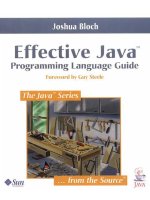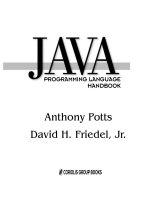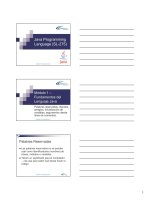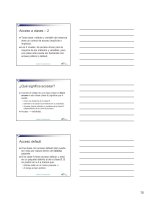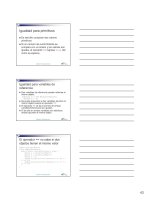Lecture Java programming language: Methods - Ho Dac Hung
Bạn đang xem bản rút gọn của tài liệu. Xem và tải ngay bản đầy đủ của tài liệu tại đây (137.3 KB, 10 trang )
Methods
Ho Dac Hung
1
Program Development Using
Methods
The solution to a task can be developed by
breaking the task down into smaller subtasks.
These subtasks can then be reduced to yet
simpler task. This problem-solving approach
described a software development process called
top-doen development.
2
Program Development Using
Methods
In
top-down development, the first level of
subtasks translate into the main() method. Levels
of tasks below main() are developed into a series
of additional methods.
3
Writing Methods
A method consists of a declaration and a body.
The method declaration includes access level,
return type, name, and parameters, if any. The
method body contains the statements that
implement the method. A method takes the form:
<access level> <return type> <name>
(
<statements>
}
4
Method Parameters
A
method declaration can include method
parameters, which accept values from the
method call. The data passed to the method can
then be used inside the method to perform its
task.
5
Method Parameters
Data is given, or passed to a method by
enclosing the data in parentheses in the method
call. The value or variable passed to a method is
called the argument.
6
Method Parameters
In Java, arguments are passed by value, which
means that the data stored in an argument is
pass. An argument that is a primitive data type
gives the method a copy of its value. An
argument that is an object gives the method a
copy of its reference.
When a method declaration includes more than
one parameterm the parameters are seperated
by commas.
7
Method Overloading
The method declaration is used by the compiler
to determine which method is execute. Therefore,
methods name do not have to be unique as long
as the parameters are different foe methods with
the same name.
Method overloading is when more than one
method of the same name is included in a class.
8
The return Statement
A
method can return a value. The return
statement is used to send a value back to the
calling statement. A return statement can return
only one “value”.
A method that return a value must include the
return type in the method declaration.
9
Documenting Methods
Methods should be carefully commented so that a
reader of the program understands what task the
method is performing and what data, if any, will
be
returned
by
the
method.
Method
documentation is in the form of documentation
comments.
10


